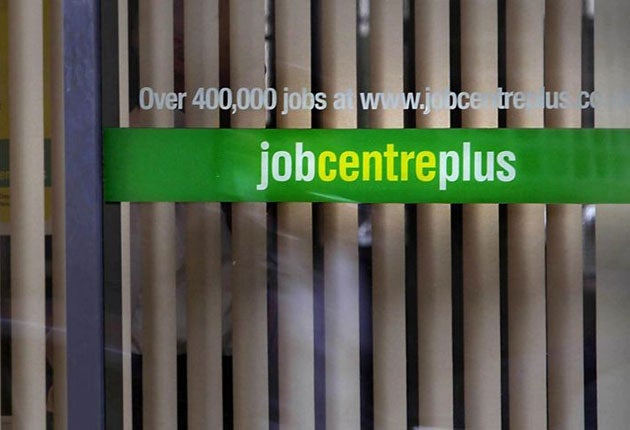UK unemployment total falls by 88,000

Your support helps us to tell the story
From reproductive rights to climate change to Big Tech, The Independent is on the ground when the story is developing. Whether it's investigating the financials of Elon Musk's pro-Trump PAC or producing our latest documentary, 'The A Word', which shines a light on the American women fighting for reproductive rights, we know how important it is to parse out the facts from the messaging.
At such a critical moment in US history, we need reporters on the ground. Your donation allows us to keep sending journalists to speak to both sides of the story.
The Independent is trusted by Americans across the entire political spectrum. And unlike many other quality news outlets, we choose not to lock Americans out of our reporting and analysis with paywalls. We believe quality journalism should be available to everyone, paid for by those who can afford it.
Your support makes all the difference.The Government today welcomed an "encouraging" fall in unemployment and a rise in jobs although unions expressed concern about huge cuts among the public sector workforce.
Unemployment fell by 88,000 in the three months to April, the biggest quarterly cut in more than a decade, taking the jobless total to 2.43 million.
But the news was marred by an increase of 19,600 in the number of people claiming Jobseeker's Allowance (JSA) last month to 1.49 million, the worst figure for more than a year.
Economic inactivity increased by 39,000 in the three months to April to reach 9.37 million, more than a fifth of the working age population.
Government hopes that private firms will create jobs as posts are cut in the public sector were given a boost with news that employment in the private sector increased by 104,000 in the first three months of the year to 23 million.
At the same time, public sector employment fell by 24,000 over the quarter and by 143,000 over the past year, to 6.1 million, and the decline would have been bigger but for the 15,000 temporary jobs created to deal with the Census.
Employment minister Chris Grayling said: "This is another encouraging set of figures and a very welcome drop in unemployment.
"It's also good news that employment is going in the right direction with half a million more people in private sector jobs compared to this time last year.
"The fall in the number of unemployed young people also means that the total is now lower than it was before the General Election. However, we still face a challenge to help more of the long-term unemployed into work."
Dave Prentis, general secretary of the Unison union, said: "The small fall in the jobless total will be no comfort to the hundreds of thousands of public sector workers with redundancy notices hanging over their heads."
TUC general secretary Brendan Barber said: "Today's unemployment figures are a welcome tonic to the raft of recent poor economic data. The significant fall in youth unemployment is encouraging.
"But with 820,000 more people out of work now than they were before the recession, the labour market is still a long way off a return to full fitness."
The 88,000 fall in unemployment in the three months to April was the biggest quarterly cut since the summer of 2000.
The reduction was mainly among 16 to 24-year-olds, with unemployment in this age group being cut by 79,000 to 895,000, the lowest figure for two years.
Other data from the Office for National Statistics showed that employment increased by 80,000 to 29.2 million, still 333,000 lower than the pre-recession peak in May 2008.
The number of men claiming JSA increased by 11,000 to more than a million, while 8,500 more women joined the claimant count, taking the total to 483,700, the highest figure since 1996.
Annual earnings increased by 1.8% in the year to April, down by 0.6% on the previous month, largely because of lower growth in bonuses in private firms.
John Philpott, chief economic adviser at the Chartered Institute of Personnel and Development, said: "The only obvious concerns are that job vacancies appear to be drying up, while the number of people on Jobseeker's Allowance is clearly on the rise, although the latter increase owes much to changes in the benefit regime and should not in itself be taken as a sign that the jobs market is starting to weaken.
"Another potential worry is the ongoing scale of job losses in the public sector."
Neil Carberry, the CBI's director for employment, said: "It is good news that unemployment figures have fallen, with the private sector creating jobs.
"We hope this will continue in the coming months, but we still have a serious problem with long-term unemployment and inactivity. We need to tackle the structural causes of unemployment to get the UK working."
Unemployment in the regions between February and April was:
Region / Total / Change / Unemployment
North East / 118,000 / minus 8,000 / 9.5%
North West / 277,000 / plus 13,000 / 8.1%
Yorkshire/Humber / 237,000 minus / 8,000 / 9.0%
East Midlands / 176,000 / minus 6,000 / 7.6%
West Midlands / 235,000 / minus 28,000 / 8.8%
East / 191,000 / plus 8,000 / 6.3%
London / 384,000 / minus 12,000 / 9.0%
South East / 255,000 / minus 25,000 / 5.7%
South West / 174,000 / plus 4,000 / 6.5%
Wales / 115,000 / minus 9,000 / 7.9%
Scotland / 207,000 / minus 10,000 / 7.7%
N Ireland / 61,000 / minus 6,000 / 7.2%
Join our commenting forum
Join thought-provoking conversations, follow other Independent readers and see their replies
Comments